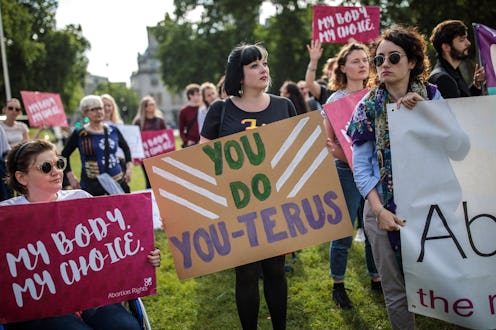Life
This Is Who Abortion Restrictions Affect The Most

The fight for reproductive rights, control over our bodies, and access to safe and affordable healthcare is an ongoing one. While we've enjoyed certain victories, there are still many unsettling truths that remain — one of which is the fact that abortion restrictions affect the most vulnerable people people in the United States the most. It's not breaking news — indeed, the results of the current report have been found in previous research — but that doesn't make it any less detrimental. For the umpteenth time, it underlines how important access to safe, legal abortion is.
The data comes from the National Network of Abortion Funds, and it reminds us that three demographics of women in particular are disproportionately impacted by how difficult it already is to get an abortion: Low-income women, young women, and black women. And with abortion restrictions potentially growing even stricter (a number of states only have one abortion provider left), their future is not looking promising. The report looked at data from five years from the George Tiller Memorial Abortion Fund, which gives financial aid to women who need help paying for their abortion care. Since there is no Medicaid funding for abortion in the United States due to the Hyde Amendment, organizations like George Tiller are vital for low-income people or those who don't have private insurance.
The organization's findings revealed consistent patterns. More than a third of the patients needing assistance from the fund also received some sort of public assistance, like SNAP or unemployment benefits. In addition, about 70 percent of the women in the report needed financial aid for second-trimester abortions. Now, the George Tiller Fund does prioritize second-trimester abortions, which could explain the high number here. But we also need to acknowledge that another explanation could be that people needed help simply because they couldn't afford an abortion to begin with.
To make matters worse, abortion care is a race against the clock: The longer you have to wait, the more expensive it gets. These same people also needed to travel almost 175 miles to get abortion care — which leads us to an even more startling discovery: Between 2010 and 2014, the average distance women had to travel for abortion care doubled. During this time, abortion restriction skyrocketed. Furthermore, most of the women who needed help were in the South and Midwest, where many states restrict private insurance coverage for women who need abortions. I doubt that the correlation is a coincidence.
For years, research has found that the financial burden is a major obstacle for people seeking abortions. A 2009 review of research from the Guttmacher Institute found that somewhere between 18 and 37 percent of women on Medicaid end up giving birth when they really wanted an abortion — all because of the money.
Furthermore, half of the women who asked for help were black — but black women are only 38 percent of abortion patients in this country. Sound familiar? It should. Black women are also likelier to die during childbirth and of cervical cancer. Why the discrepancy? (Hint: It begins with "systemic" and ends with "racism.") Plus, the majority of U.S. women of color live in states considered "hostile" toward abortion.
When abortion is legal, it's very safe; it only becomes unsafe when people cannot access them legally. Also, we know that restricting abortion access doesn't make abortions any less common — it just makes the ones that do happen (surprise!) incredibly unsafe. Considering that (according to the World Health Organization) 22 million women worldwide end up having to seek unsafe abortions every single year, and 47,000 women die from them, shouldn't we be doing everything we can to make safe abortion easily accessible?
And yet, lawmakers continue to push for restrictions, despite the fact that as they do so, they are actively harming a huge number of people. It proves more than ever how much organizations that help make these services accessible are needed — and how badly we need to fight for them. Here are some actions you can take literally right now to help.
Let's get to work.
Image: Getty Images